Article written by Elisa - Travel Writer & Local in France
This article may contain compensated links. Please read disclaimer for more info.
The south of France is a wonderful area to explore, renowned for its beauty and relaxed lifestyle, and attracting visitors worldwide.
Some picturesque villages in southern France are highlighted by the presence of impressive castles, mostly dating from the Middle Ages to the Renaissance. Unlike the graceful Loire Valley Castles, the castles in southern France are mostly massive structures built for military purposes, with less or no attention to detail. Still, the castles in the south of France are beautiful French châteaux in their own way.
A visit to the castles in southern France is always a journey through time and another way to discover the regional historical and cultural heritage. With family, couple, or friends, check out our selection of the most beautiful castles in southern France, located in the regions of Occitanie and Provence-Alpes-Côte d’Azur. You can read more about these French regions here.
How to Visit the Best Castles in Southern France
The best way to visit most of these beautiful castles in southern France is by car. You can plan wonderful French road trips that include one or a couple of these southern France castles. Click here for our best tips on driving in France.
Cathar Castles in Southern France
The Cathar Castles are the castles and fortresses related to the Cathars. Catharism was a Christian dualist movement that thrived in southern Europe, especially in France’s Languedoc region, between the 12th and the 14th centuries. The Catholic Church considered the Cathars as heretics and launched the Albigensian Crusade to exterminate them. Therefore, the Cathar Castles had a defensive role in protecting its inhabitants from the crusaders.
The Cathar Castles are located in the French departments of Aude and Ariège in Occitanie, and they are all stunning buildings. They are best explored on a road trip through the Cathar Country, starting from Carcassonne or Narbonne.
Carcassonne Castle
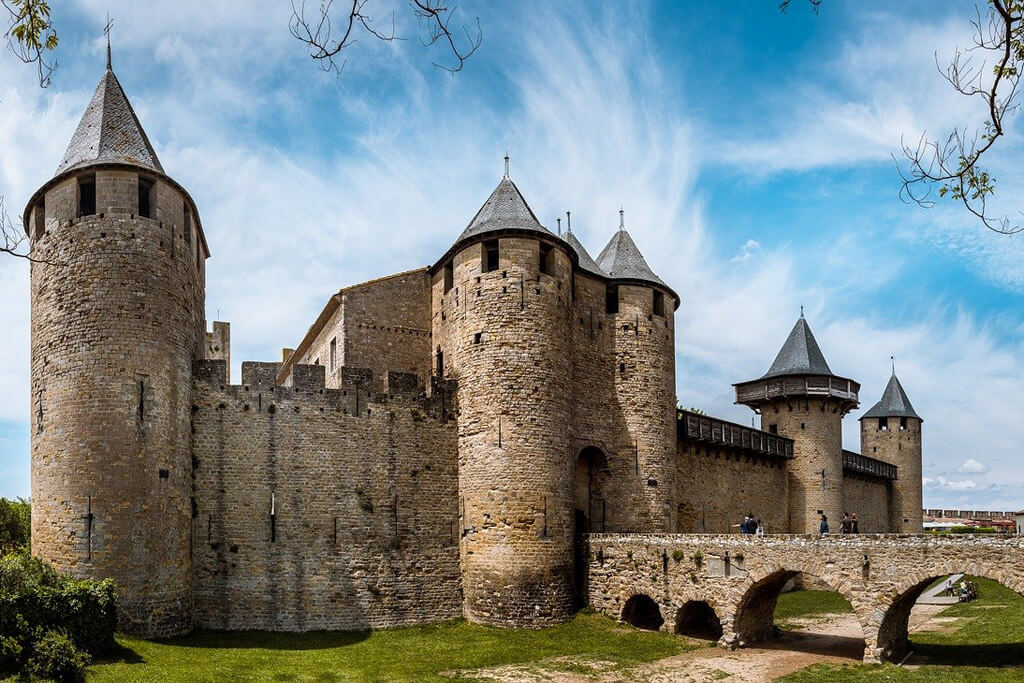
The stunning Château Comtal – or Count’s Castle – is inside the Cité de Carcassonne. This impressive medieval castle was built in the 12th century over the western part of the city’s Roman walls. The castle was surrounded by a rectangular fortified enclosure in 1226.
The Carcassonne Castle is rectangular in shape, with an inner courtyard. Visitors can see the remains of the Counts’ private chapel and a museum with an interesting collection of objects related to the Cathars. The castle is separated from the city by a deep moat and defended by two barbicans.
The castle’s six towers are pierced with stirrup loopholes, and the curtain walls and the top of the towers can be used with hoists. The western flank of the walls, against which the Carcassonne Castle is built, is defended by the highest tower in the Cité.
Today, the fortified castle’s walls support a reconstruction of hoardings between the door and the Major’s tower. The hoardings are the covered wooden walkways with openings that allowed soldiers to launch projectiles at invaders.
The castle of Carcassonne’s entrance is on the eastern side, and there’s an entrance fee to visit the castle and ramparts. Save time and buy your tickets online here.
Château de Peyrepertuse
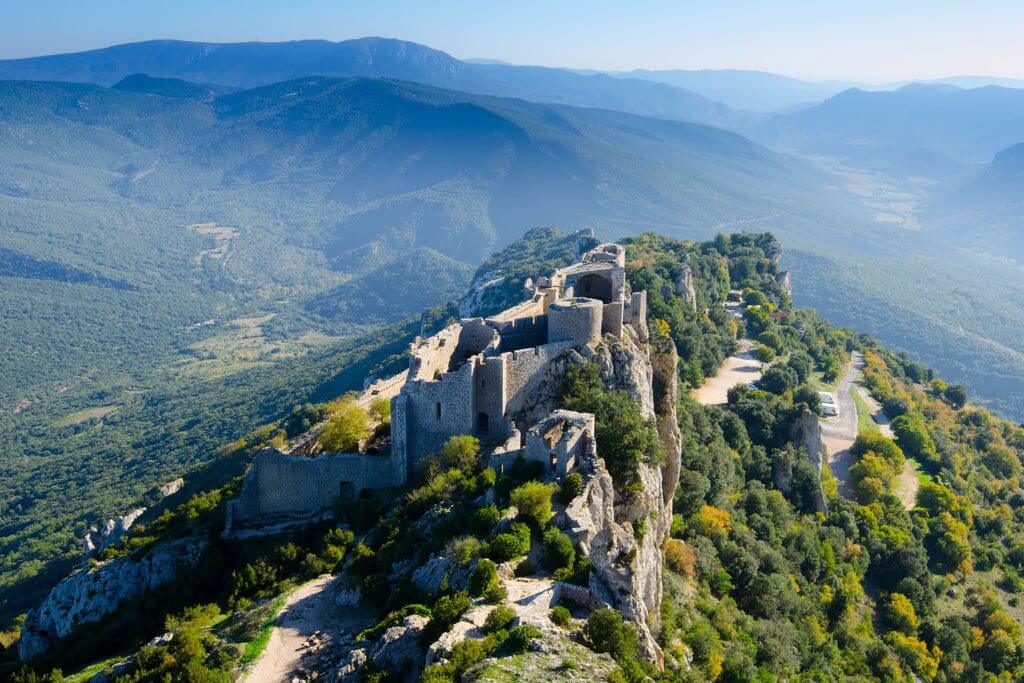
Château de Peyrepertuse is a Cathar castle in ruins located in the village of Duilhac sous Peyrepertuse, in the department of Aude. This medieval castle in southern France was built between the 10th and 13th centuries on a limestone ridge at an altitude of 800m, perched on a 40-meter cliff.
Château de Peyrepertuse’s strategic location allowed its inhabitants to see far into the valleys, control the mountain passes, and send communication signals to the neighbor Cathar castle of Quéribus.
At the time of the Crusade against the Cathars, the castle was the fiefdom of Guillaume de Peyrepertuse, who, not wanting to submit, was excommunicated in 1224. After the failure of the siege of Carcassonne, Guillaume did finally submit, and the castle became a French possession in 1240.
Plan your visit to Château de Peyrepertuse: https://www.peyrepertuse.com/home/
Châteaux de Lastours
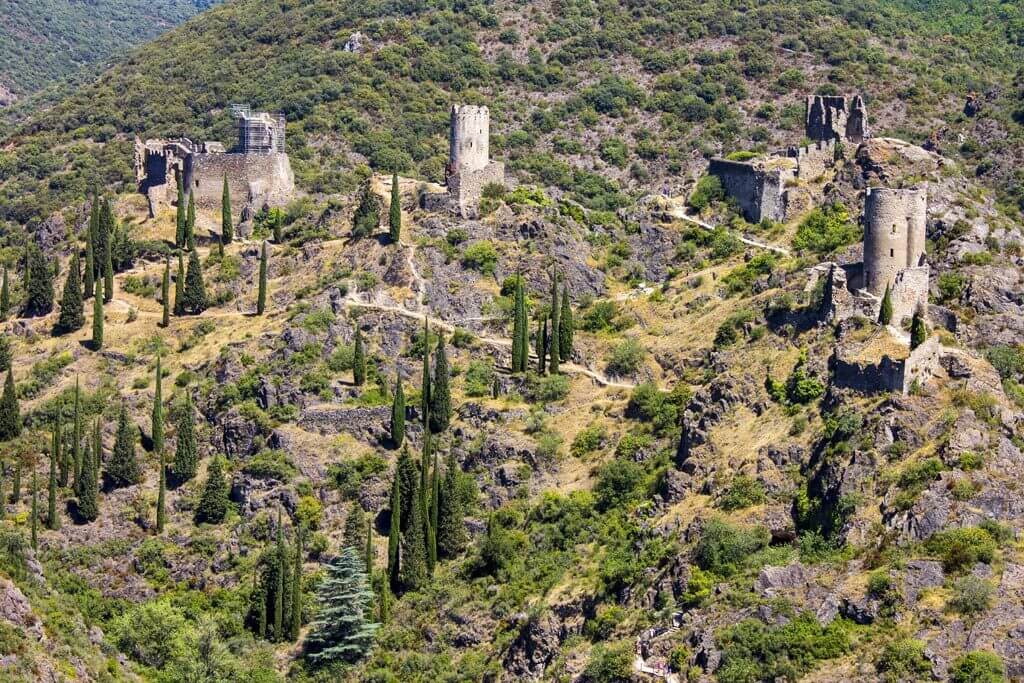
Châteaux de Lastours is an ensemble of four Cathar Castles (Cabaret, Surdespine, Quertineux, and Tour Régine) built on the top of a rocky spur 300 meters above the village of Lastours and isolated by the deep valleys of Orbiel and Grésillou. Châteaux de Lastours are located in the department of Aude.
During the Middle Ages, the site belonged to the Lords of Cabaret, who were very attached to Catharism, and there were only three castles (Cabaret, Surdespine, and Quertineux). During the Crusades, the castles were destroyed and reconstructed several times, and their position changed too.
After the Cathar Crusade, the King of France took possession of the defeated lords’ goods and territories. The king destroyed the village attached to the castles (the Castrum Cabaret) and built the fourth tower, Tour Régine, on the top of the three primary structures.
The visit takes place in two stages: the discovery of the panorama from the Belvedere Montfermier and the access to the monuments by a landscaped hiking trail.
Plan your visit to Châteaux de Lastours: http://www.chateauxdelastours.fr/ (in French).
Other Castles in Occitanie
In Occitanie, there are many more beautiful castles and fortresses non-related to the Cathars. Most of these castles in southern France were built for defensive purposes and experienced the Franco-Spanish battles and wars for the border.
Château Royal de Collioure
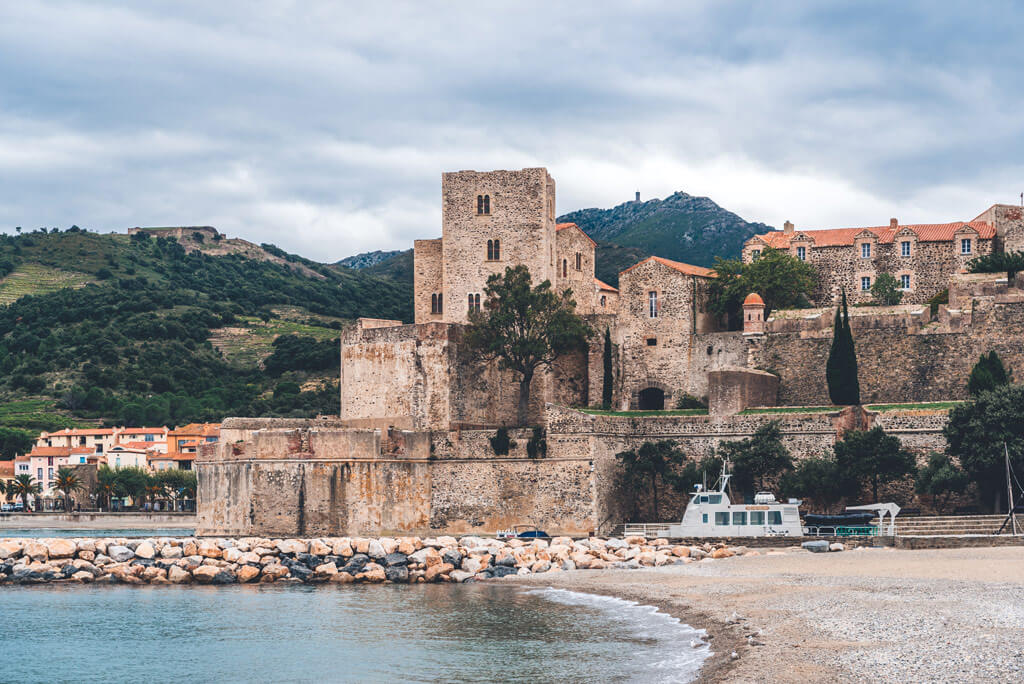
This picturesque medieval château is located in the seaside town of Collioure, in the department of Pyrénées-Orientales. The current château is a juxtaposition of at least four castles, and the first structures date back to the 7th century.
This former seigniorial residence belonged to the Counts of Roussillon and then the Kings of Aragon. Later in the 13th century, the castle became the Kings of Mallorca’s royal residence, and it was embellished.
In the 16th century, the Kings of Spain transformed the Royal Castle into a citadel, and the castle defenses and its surroundings were considerably reinforced.
In the 17th century, Collioure was at stake in the wars between the Spanish Habsburgs and the French Bourbons. After the Treaty of the Pyrenees (1659), when the Roussillon became part of France, Vauban gave it its current appearance. Transformed into a prison in 1939, it became the first disciplinary military camp for refugees from the Spanish Civil War.
The entrance to this beautiful château built by the sea, includes a guided visit (1hr 30 min).
Plan your visit to Château Royal de Collioure: https://www.ledepartement66.fr/dossier/le-chateau-royal-de-collioure/ (in French).
Palais des Rois de Majorque, Perpignan
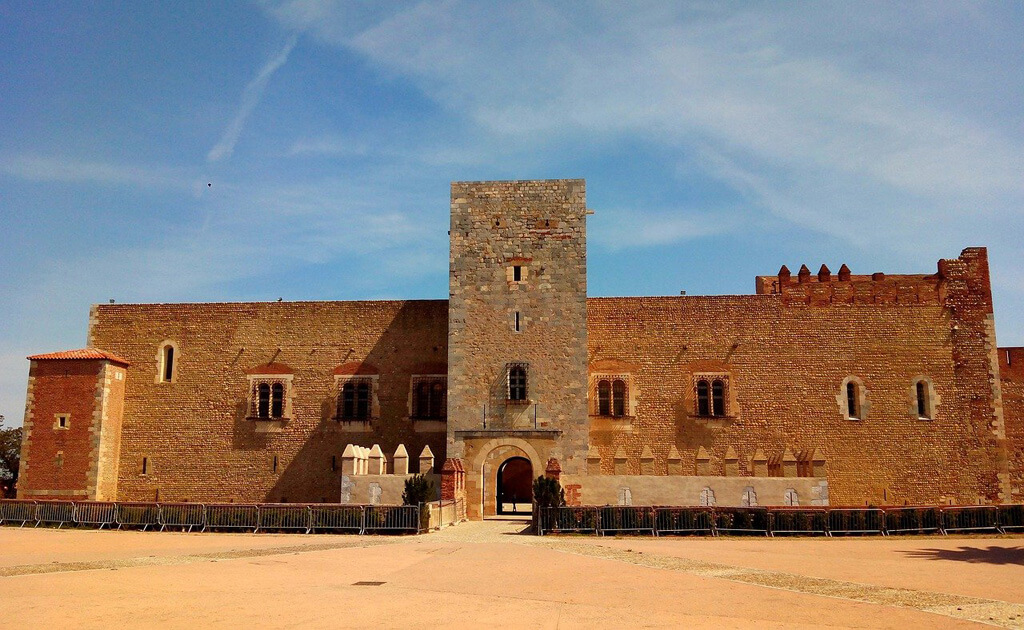
This Royal Palace is a castle-fortress built in Gothic style located in Perpignan, in the department Pyrénées-Orientales. Built-in the heart of the city, which it dominates from a high promontory, this superb 13th-century castle was for nearly a century the center of the ephemeral Kingdom of Mallorca.
This palace was born from the will of King of Mallorca Jaume II, who wanted a residence in the continental capital of his kingdom. The castle’s construction started in a late Romanesque style, and it was completed after 1300 in the Gothic style. The sumptuous chapels indicate all the sophistication of this period and the status of Perpignan as an economic, political, and cultural center of the Medieval Mediterranean.
The castle’s team of guides propose regularly guided visits (50 min) at no additional cost.
Plan your visit to Palais des Rois de Majorque: https://www.ledepartement66.fr/dossier/lepalaisdesroisdemajorque/ (in French and Catalan).
Castles in Provence-Alpes-Côte d’Azur
Château d’If
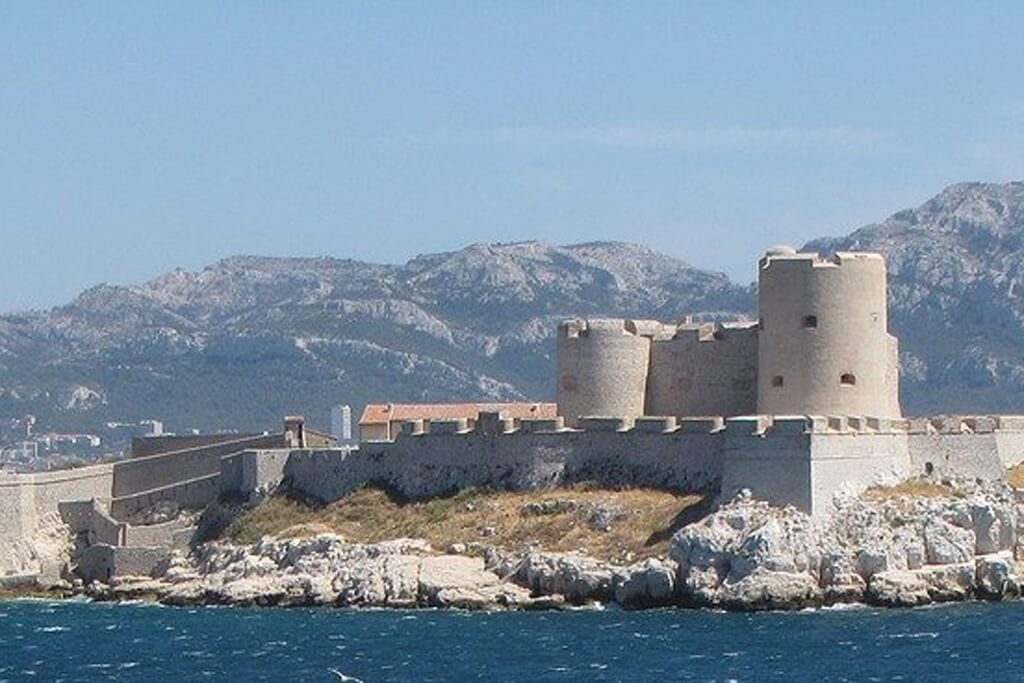
Château d’If was built by King François I in 1524 on the small If Island, located off Marseille’s coast, in the department Bouches-du-Rhône.
During its 400 years of activity, the imposing Château d´If was used primarily as a state prison. This island fortress became world-famous thanks to the novel Le Comte de Monte-Cristo by Alexandre Dumas. Here, the hero Edmond Dantès was imprisoned for 14 years.
Today, Ile d’If and its château is a popular day trip from Marseille. Numerous shuttle boats link Marseille’s Old Port to Ile d’If hourly, and the guided visit of the château is fascinating. Don’t miss the view of Marseille from the château’s summit; it is stunning!
Plan your visit to Château d’If: http://www.chateau-if.fr/en/
Buy your tickets to Château d’If
Château d’Esparron-de-Verdon
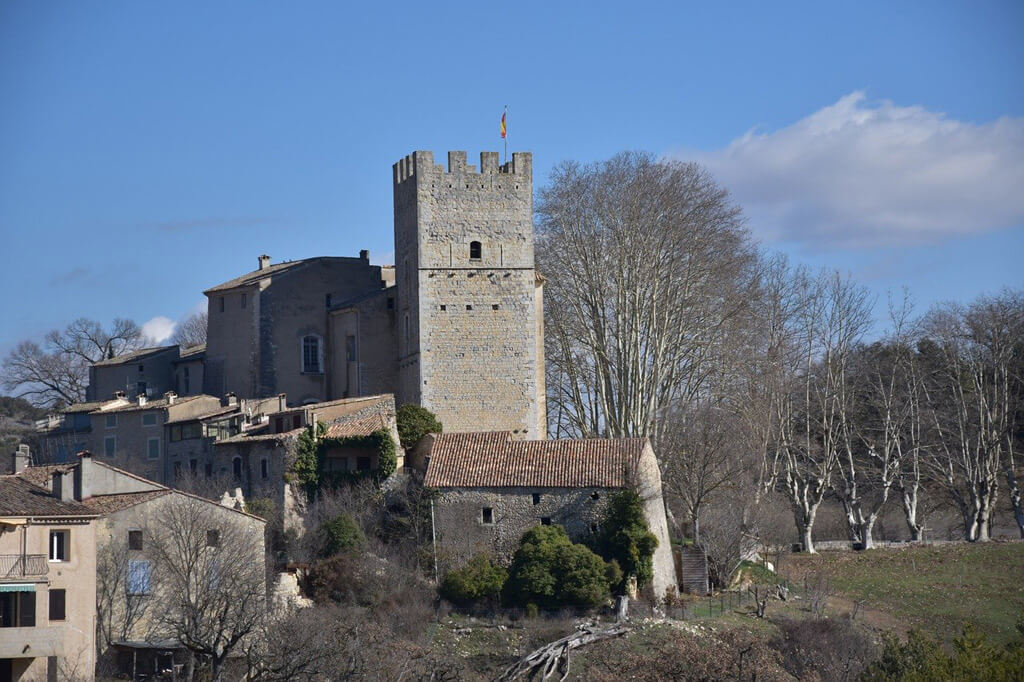
Château d’Esparron-de-Verdon is a medieval castle located in the heart of the Verdon Regional Park, in the department of Alpes-de-Haute-Provence.
Overlooking the old village on one side and the countryside on the other, the original building was added until the 18th century and so is an interesting mix of architectural styles. The imposing 30-meter defensive tower is particularly remarkable, and it provides panoramic views of Lake Esparron, which is only a short walk away.
Château d’Esparron is a listed historic building and has been in the Castellane family ever since its foundation in the 13th century. Château d’Esparron offers B&B accommodations and self-catering apartments with free WiFi access so you can sleep in a historical castle during your road trip through the Gorges du Verdon.
Click here to book your stay at Château d’Esparron
Château Grimaldi, Antibes
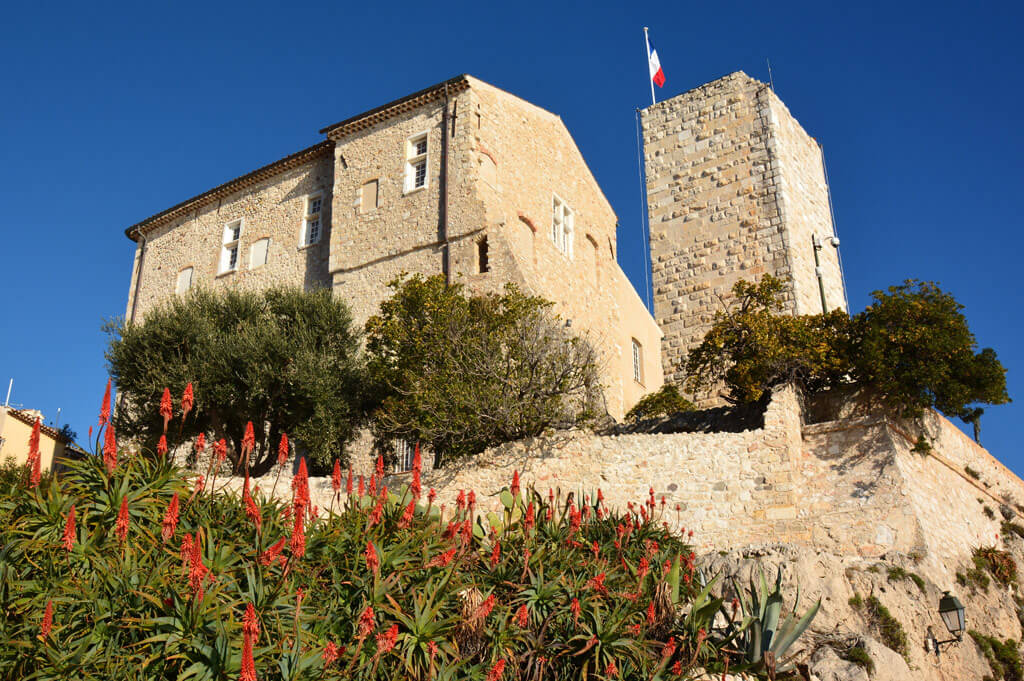
Château Grimaldi in Antibes, in the department of Alpes-Maritimes, was built at the end of the 11th century as a residence for Monaco’s ruling family. The castle was built on foundations from the Roman period (1st century AD ), and it preserves part of the facades of the Roman building to a height varying from 3 to 5 meters.
Inside, the 25-meter tower dominates the castle, and it has cut stones from Roman monuments at the base. Like all Romanesque keeps, the door is located high to allow access to the first-floor room only by a sliding ladder.
In 1925, the Grimaldi castle was bought by the city of Antibes, and it became the Grimaldi Museum.
In 1946 Pablo Picasso was offered the opportunity to set up his workshop in the castle. When he left, Picasso left in deposit in Antibes 23 paintings and 44 drawings. Over the years, the city enlarged the Picasso collection with new acquisitions, and in 1966 the Château Grimaldi became officially the Musée Picasso, the first museum dedicated to the artist.
Plan your visit to Château Grimaldi: https://www.antibesjuanlespins.com/en/must-see-must-do/culture-and-heritage/museums/picasso-museum-2031894
Château de Lourmarin
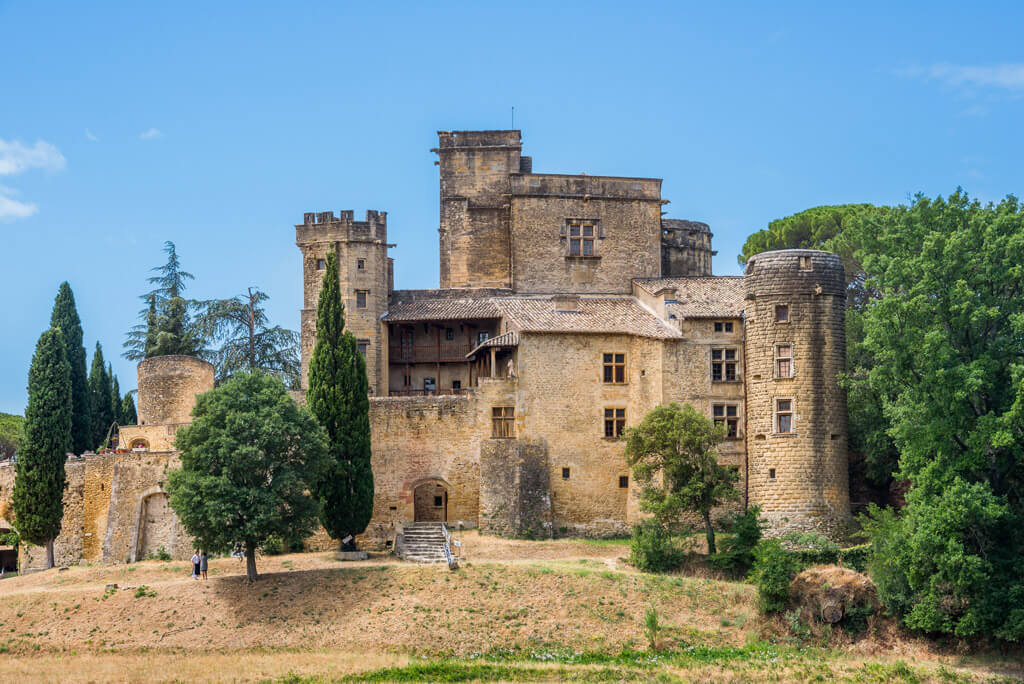
Château de Lourmarin is one of the most beautiful castles in southern France. It is located in the picturesque village of Lourmarin, in the Vaucluse department.
The Renaissance castle was built in two phases. The first part of the castle was built in the 15th century, on the ruins of a fortress dating from the 12th century, and the second during the first half of the 16th century. The Château de Lourmarin is nicknamed the little Villa Medici in Provence, mainly for its ceremonial spiral staircase, loggia, fireplaces, and parkland.
The visit to the château will allow you to admire its architecture, but also the period furniture, works of art, musical instruments, and engravings.
Plan your visit to Château de Lourmarin: http://www.chateau-de-lourmarin.com/the-vibert-foundation/
Château de la Napoule, Cannes
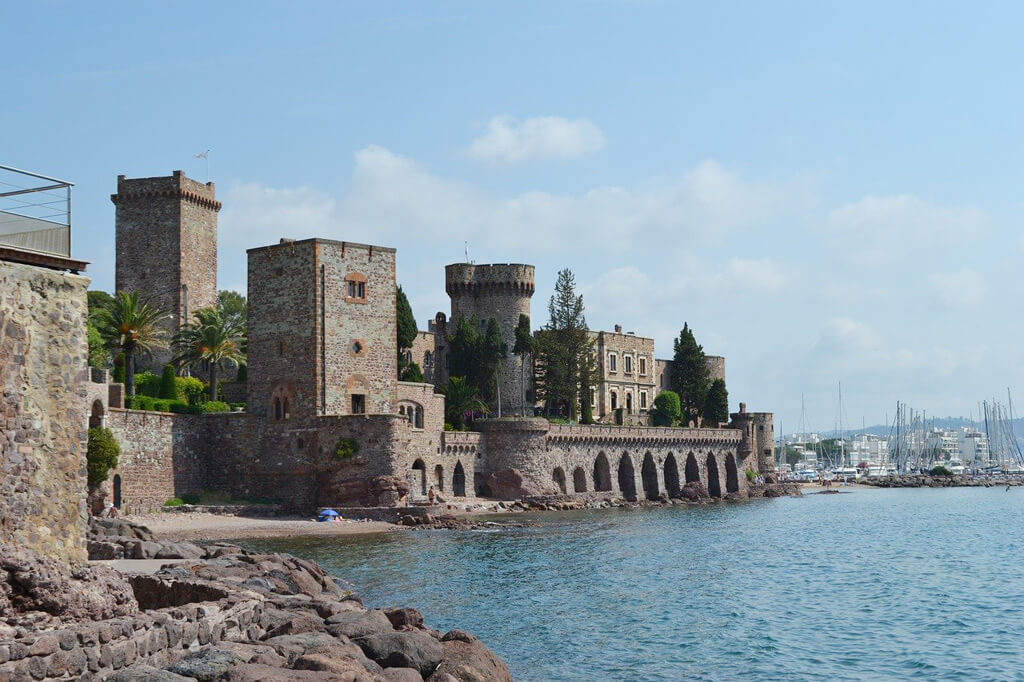
Château de la Napoule is an old medieval fortress located in Mandelieu-la-Napoule, in the Alpes-Maritimes department. This beautiful castle in southern France was built right by the sea in 1387 by the Counts of Villeneuve.
Château de la Napoule suffered numerous transformations during its life, and it was witness to invasions, looting, wars, and revolutions.
Half bourgeois villa – half ruins, the château was bought in 1917 by the Clews, a couple of rich American artists, who restored it and added sections in their own personal style.
The château and gardens are listed as Historical Monuments. Also, the gardens are classified as ‘remarkable’ and house works of visual artists.
Plan your visit to Château de la Napoule: http://www.chateau-lanapoule.com/en/
Château de Tarascon
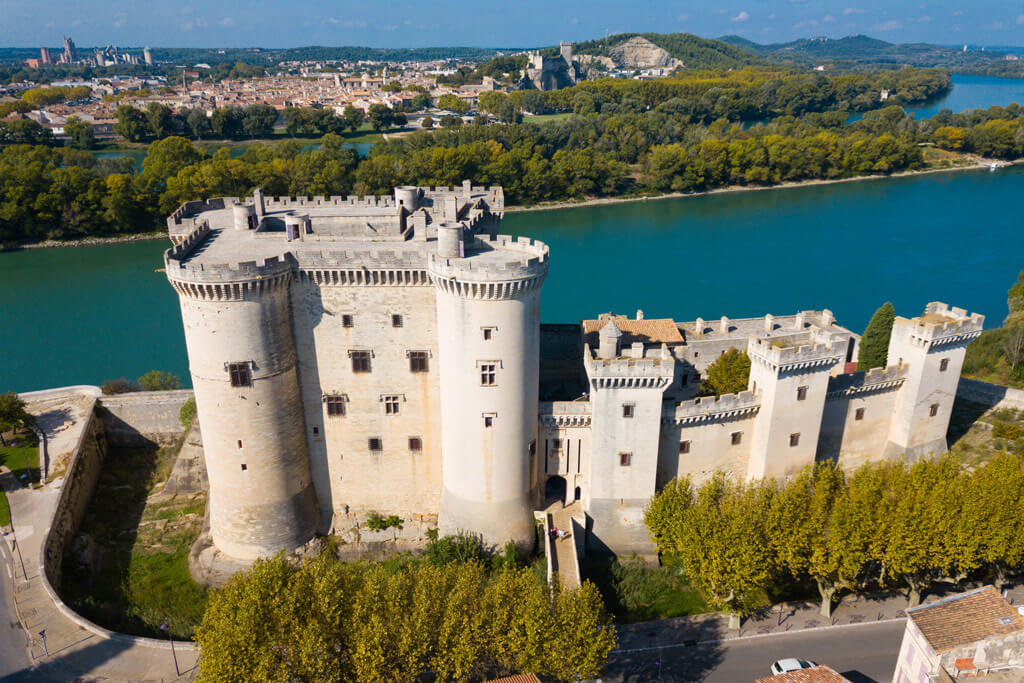
Château de Tarascon, located in the Bouches-du-Rhône department, is a castle-fortress built by the Dukes of Anjou, counts of Provence. This magnificent and well-preserved castle is one of the most beautiful medieval castles in south of France and Europe.
Château de Tarascon was built at the beginning of the 15th century on a rocky islet, and on the remains of a 13th-century château. The new castle’s design was inspired by the Bastille’s architectural design, and it had a residential and military function. The terrace of the château offers a panoramic view of the river, the Alpilles, and the Montagnette.
King René d’Anjou, heir to Provence’s county, made some modifications to the building between 1447 and 1449 to make the castle more habitable. During his many stays, he made the castle a privileged meeting place.
Upon the death of René’s heir, the earldom of Provence was ceded to Louis XI, King of France, and the fortress lost its strategic interest. From the 18th century up to 1926, the château functioned as a state prison. Today it is the property of the city of Tarascon.
Plan your visit to Château de Tarascon: http://chateau.tarascon.fr/ (in French)

